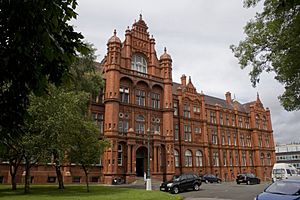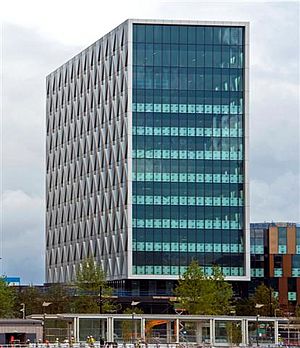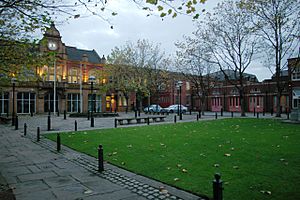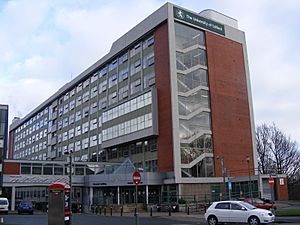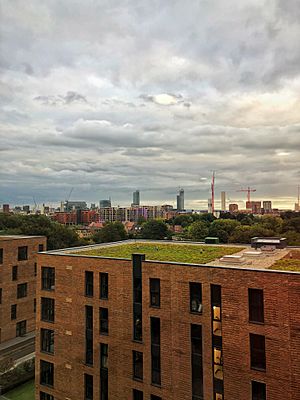University of Salford facts for kids
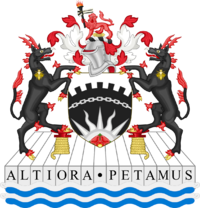
Coat of Arms
University of Salford |
|
| Motto | Latin: Altiora Petamus |
|---|---|
|
Motto in English
|
"Let us seek higher things" |
| Type | Public |
| Established | 1850 - Pendleton Mechanics Institute 1896 – Royal Technical Institute, Salford 1967 – gained university status by Royal charter |
| Endowment | £1.4m (2020) |
| Chancellor | Lucy Meacock |
| Vice-Chancellor | Nic Beech |
|
Administrative staff
|
2,781 |
| Students | 20,520 (2015/16) |
| Undergraduates | 15,475 (2015/16) |
| Postgraduates | 4,520 (2015/16) |
| Location |
,
England, United Kingdom
|
| Campus | Urban, Parkland |
| Colours | Black and Red |
| Affiliations | University Alliance Association of Commonwealth Universities Northern Consortium Universities UK |
 |
|
The University of Salford is a public research university located in Salford, Greater Manchester, England. It is about 1 mile (1.6 km) west of Manchester city centre. The university started as the Royal Technical Institute, Salford, which opened in 1896. It became a university in 1967.
The university has 20,520 students. It is set in 160 acres (65 ha) of parkland next to the River Irwell.
Contents
University History: How it Started
Early Days: Royal Technical Institute
The university began in 1896 as the Royal Technical Institute, Salford. This was a mix of two older schools: Salford Working Men's College (from 1858) and Pendleton Mechanics' Institute (from 1850). The institute got the name 'Royal' because the Duke and Duchess of York (who later became King George V and Queen Mary) attended its opening. This event is remembered in the university's Peel Building.
In the early 1900s, Salford was a busy industrial area. Because of this, the institute first offered subjects like Engineering, Electrical Engineering, Chemistry, and Textiles. About 1,240 students joined in the first year. There were 19 teachers.
In 1921, the institute changed its name to the Royal Technical College, Salford. Later, in 1958, it split into two parts. One part kept the name Royal Technical College. The other became Peel Park Technical College, which later changed its name a few times before becoming University College Salford in 1992.
Becoming a University
In 1956, the Royal Technical College became a College of Advanced Technology. Then, in 1963, a government report suggested that these colleges should become universities.
The Royal College of Advanced Technology officially became the University of Salford on February 10, 1967. Queen Elizabeth II gave the university its special Royal Charter. The first leader of the university was Clifford Whitworth. The main library is now named after him. Prince Philip, Duke of Edinburgh, was the first Chancellor (a special ceremonial head) of the university until 1991. He was very interested in the university.
In 1996, the two parts of the university, University College Salford and the University of Salford, joined back together. In 2012, the university started working with BAE Systems and other universities on a project called the Gamma Programme. This project aims to develop "autonomous systems," which are like smart robots or self-driving vehicles.
Campus and Buildings
The main campus, called Peel Park, is less than 1.5 miles (2.4 km) from Manchester city centre. It is located by the River Irwell and next to Peel Park. This park was one of the first public parks in the world, opening in 1846. Students often say Salford is a relaxed campus. It is close to Manchester but also has more green spaces.
Salford Crescent railway station is right next to the campus. There are also many buses that go to Manchester, Salford, Bolton, and Liverpool. Other university buildings, like the Frederick Road and Adelphi campuses, are also nearby. The Salford Museum and Art Gallery, which was one of the first free public libraries in England, is on the Peel Park Campus.
MediaCityUK Campus
In October 2010, the university opened a new learning and research space at MediaCityUK. This is a special area where many media companies, like the BBC, are located. Students can study many different programs here.
New Buildings and Updates
The university has invested a lot of money to build new facilities and update old ones. Some of these projects include:
- The Mary Seacole Building, opened in 2006, for Health and Social Care students.
- The Lady Hale Building, opened in 2008, for the Law School.
- The Joule Physics Laboratory, for physics teaching.
- A new building at MediaCityUK for Arts, Media & Social Sciences students, opened in 2011.
In 2013, work began on the £55 million New Adelphi building. This building opened in 2016 and is for music, performance, art, design, and architecture students. It has a theatre, TV studios, rehearsal rooms, recording studios, dance studios, workshops, and photographic studios.
A new £65 million engineering building is also being built to replace the older Newton building. It is expected to open in late 2022.
University Library
The main library, called the Clifford Whitworth Library, opened in 1971. It was renamed in 1984 after the university's first Vice-Chancellor, Clifford Whitworth. The library was greatly updated between 2016 and 2018.
Other Facilities
- Peel Hall: This hall is in the Peel Building and can seat almost 400 people. It hosts many music performances.
- Robert Powell Theatre: Named after an actor from Salford, this theatre shows modern plays and performances for young audiences.
- Chapman Gallery: Located on the Peel Park Campus, this gallery displays art from new artists, university staff, and students.
- Tom Husband Leisure Centre: This centre on the Peel Park Campus has a gym, swimming pool, sauna, squash courts, climbing wall, and a sports hall.
- Adelphi Studio Theatre: A smaller theatre in the Adelphi Building.
University Leadership
Chancellors
The Chancellor is a ceremonial head of the university.
- Prince Philip, Duke of Edinburgh (1967–1991)
- Sarah, Duchess of York (1992–1995)
- Sir Walter Bodmer (1995–2006)
- Sir Martin Harris (2007–2009)
- Irene Zubaida Khan (2009–2014)
- Jackie Kay (2014–2021)
- Lucy Meacock (2022-Current)
Vice-Chancellors
The Vice-Chancellor is the main leader who manages the university.
- Clifford Whitworth (1967–74)
- John Harold Horlock (1974–81)
- Sir John Michael Ashworth (1981–89)
- Thomas Mutrie Husband (1990–97)
- Michael Harloe (1997–2009)
- Martin Hall (2009–14)
- Helen Marshall (2015–2023)
- Nic Beech (2023-Current)
Research Centers
The university has special centers for research:
- The United National Institute for Prosthetics and Orthotics Development: This is the only place in England that teaches about prosthetics (artificial body parts) and orthotics (devices to support body parts).
- KidsCan Children's Cancer Research Centre: Started in 2002, this center works to find better treatments for cancer in children and young adults.
What Students Study
The University of Salford is organized into four main schools:
- School of Arts, Media and Creative Technology
- School of Science, Engineering and Environment
- School of Health and Society
- Salford Business School
Many international students come to Salford from countries like China, India, Pakistan, and Nigeria. The university is also a founding member of the Northern Consortium of universities.
The university is working to make sure all students feel included and have the same chances to succeed. They are looking at ways to support students from different backgrounds.
University Rankings
| National rankings | |
|---|---|
| Complete (2021) | 73 |
| Guardian (2021) | 88 |
| Times / Sunday Times (2021) | 91 |
| Global rankings | |
| QS (2021) |
901–950 |
| THE (2021) | 801–1000 |
| British Government assessment | |
| Teaching Excellence Framework | Bronze |
University rankings show how a university compares to others. In 2018, The Guardian newspaper ranked the University of Salford 99th in the UK. The Times newspaper ranked Salford 105th out of 123 UK universities in 2015.
Student Life
University House on the Peel Park Campus is home to the University of Salford Students' Union (USSU). This union helps students and also has shops and a bar.
The Two Cities Boat Race is a yearly boat race that started in 1972. It is a big event for students from Salford and Manchester universities. Volunteers from both universities help run the event and raise money for charities.
Student Homes
The university has several places for students to live, called halls of residence. These are self-catered, meaning students cook their own meals.
- Peel Park Quarter: This is a large complex with 1,367 rooms. It opened in 2015.
- Eddie Colman and John Lester Courts: These two buildings have 755 rooms. They are close to Salford Shopping City. Eddie Colman was a famous football player.
- Bramall Court: These flats are near the Adelphi Campus.
- iQ Salford, Seaford Road: This place has houses around a central area with a gym and shops.
- Sanctuary Students - Tramways, Seaford Road: Named after an old tram depot.
Castle Irwell Student Village used to be the largest student accommodation. It housed up to 1,600 students. However, it is no longer used.
Sports and Clubs
The university has 35 sports clubs, from football to ultimate frisbee. Each year, Salford and Chester University compete in a sports challenge called Varsity. Salford won the trophy in 2017.
Famous People from Salford University
See also
 In Spanish: Universidad de Salford para niños
In Spanish: Universidad de Salford para niños
- Armorial of UK universities
- College of advanced technology (United Kingdom)
- List of universities in the United Kingdom


